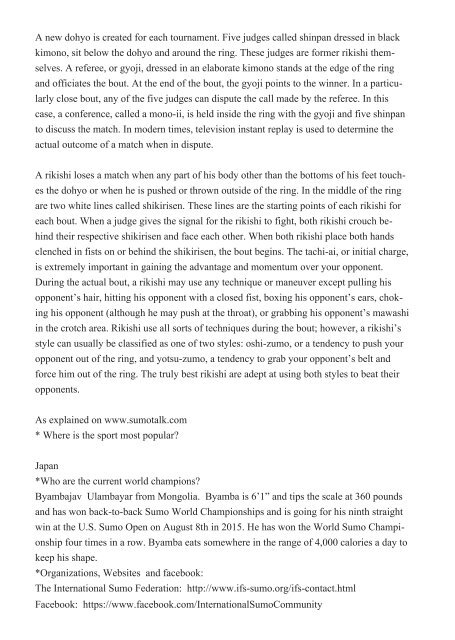HEWC Book
Create successful ePaper yourself
Turn your PDF publications into a flip-book with our unique Google optimized e-Paper software.
A new dohyo is created for each tournament. Five judges called shinpan dressed in black<br />
kimono, sit below the dohyo and around the ring. These judges are former rikishi themselves.<br />
A referee, or gyoji, dressed in an elaborate kimono stands at the edge of the ring<br />
and officiates the bout. At the end of the bout, the gyoji points to the winner. In a particularly<br />
close bout, any of the five judges can dispute the call made by the referee. In this<br />
case, a conference, called a mono-ii, is held inside the ring with the gyoji and five shinpan<br />
to discuss the match. In modern times, television instant replay is used to determine the<br />
actual outcome of a match when in dispute.<br />
A rikishi loses a match when any part of his body other than the bottoms of his feet touches<br />
the dohyo or when he is pushed or thrown outside of the ring. In the middle of the ring<br />
are two white lines called shikirisen. These lines are the starting points of each rikishi for<br />
each bout. When a judge gives the signal for the rikishi to fight, both rikishi crouch behind<br />
their respective shikirisen and face each other. When both rikishi place both hands<br />
clenched in fists on or behind the shikirisen, the bout begins. The tachi-ai, or initial charge,<br />
is extremely important in gaining the advantage and momentum over your opponent.<br />
During the actual bout, a rikishi may use any technique or maneuver except pulling his<br />
opponent’s hair, hitting his opponent with a closed fist, boxing his opponent’s ears, choking<br />
his opponent (although he may push at the throat), or grabbing his opponent’s mawashi<br />
in the crotch area. Rikishi use all sorts of techniques during the bout; however, a rikishi’s<br />
style can usually be classified as one of two styles: oshi-zumo, or a tendency to push your<br />
opponent out of the ring, and yotsu-zumo, a tendency to grab your opponent’s belt and<br />
force him out of the ring. The truly best rikishi are adept at using both styles to beat their<br />
opponents.<br />
As explained on www.sumotalk.com<br />
* Where is the sport most popular?<br />
Japan<br />
*Who are the current world champions?<br />
Byambajav Ulambayar from Mongolia. Byamba is 6’1” and tips the scale at 360 pounds<br />
and has won back-to-back Sumo World Championships and is going for his ninth straight<br />
win at the U.S. Sumo Open on August 8th in 2015. He has won the World Sumo Championship<br />
four times in a row. Byamba eats somewhere in the range of 4,000 calories a day to<br />
keep his shape.<br />
*Organizations, Websites and facebook:<br />
The International Sumo Federation: http://www.ifs-sumo.org/ifs-contact.html<br />
Facebook: https://www.facebook.com/InternationalSumoCommunity






